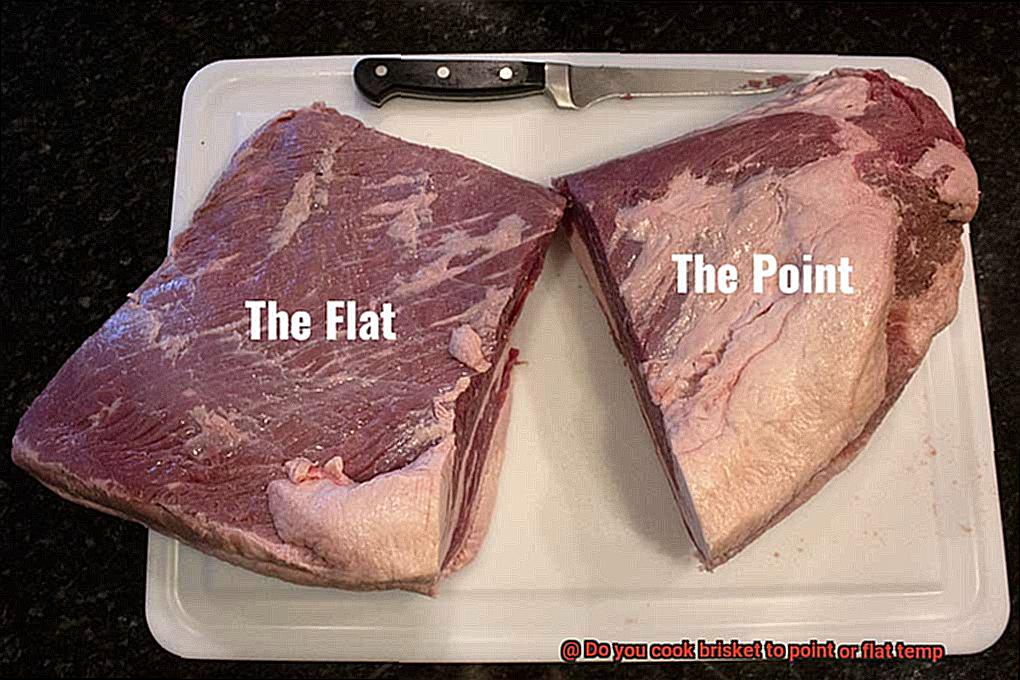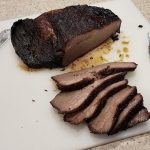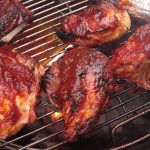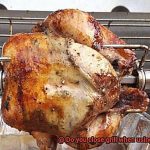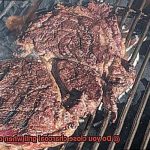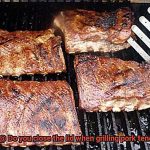Hey there, fellow meat-lovers and barbecue enthusiasts. Are you ready for the ultimate brisket experience? The kind that melts in your mouth and leaves you wanting more? Well, hold on to your tongs because we’re about to dive into a topic that can make or break your brisket game: cooking to point or flat temperature.
For those who aren’t familiar with this beefy goodness, brisket is a tough cut of meat that requires patience and skill to transform it into something magical. It comes from the breast or lower chest of the cow and is loaded with collagen and fat that need slow and low cooking methods to break down.
Now, let’s talk about the million-dollar question – do you cook brisket to point or flat temperature? Some pitmasters swear by cooking it to the point temperature (around 203°F), where the tip of the brisket feels like warm butter when pierced with a fork. They believe this produces the most tender meat. Others argue that cooking it to flat temperature (around 195°F), which takes into account the thinner, leaner part of the brisket, gives a more consistent result.
In this blog post, we’ll explore both methods in detail so you can decide which one works best for you. So get ready for some serious brisket knowledge bombs.
Contents
The Point and the Flat: Understanding the Difference
The debate is not about which part of the brisket tastes better, but rather about the difference in cooking each section to perfection. Knowing how to cook your brisket to point or flat temp can make all the difference in achieving that perfect tenderness and texture that will leave your taste buds dancing.
Let’s start with the point – the thicker, more marbled section of the brisket. If you’re looking for a tender and juicy cut, cooking to the point temperature is recommended. The point has more fat and connective tissue that needs to break down during cooking to achieve tenderness. The ideal temperature for cooking the point is around 203°F.
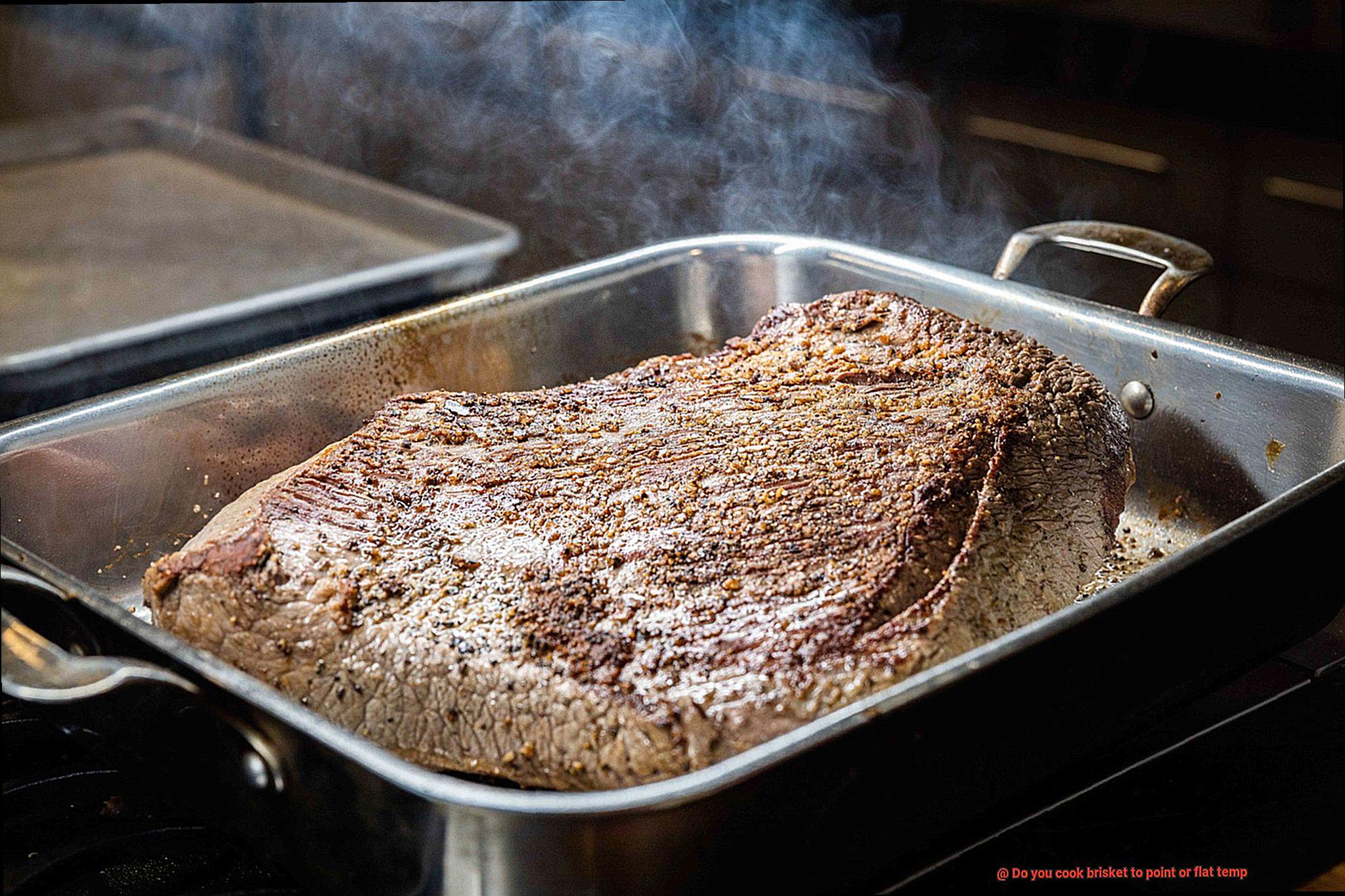
Now, let’s move on to the flat – the leaner, flatter section of the brisket. If you prefer a leaner cut with a firmer texture, then cooking to flat temperature is recommended. The flat section has fewer fats and connective tissues, which means it will cook faster and reach its optimal tenderness at a lower temperature of around 195°F.
However, cooking times and temperatures may vary depending on factors such as size and thickness of the brisket, as well as personal preferences regarding doneness levels. It is crucial to use a meat thermometer to ensure accuracy when cooking brisket.
To simplify, here are some key takeaways:
- Cooking to point temp is recommended for those who prefer tender and juicy meat.
- Cooking to flat temp is recommended for those who prefer a leaner cut with a firmer texture.
- Cooking times and temperatures may vary depending on factors such as size, thickness, and personal preferences.
- Using a meat thermometer is vital for accuracy when cooking brisket.
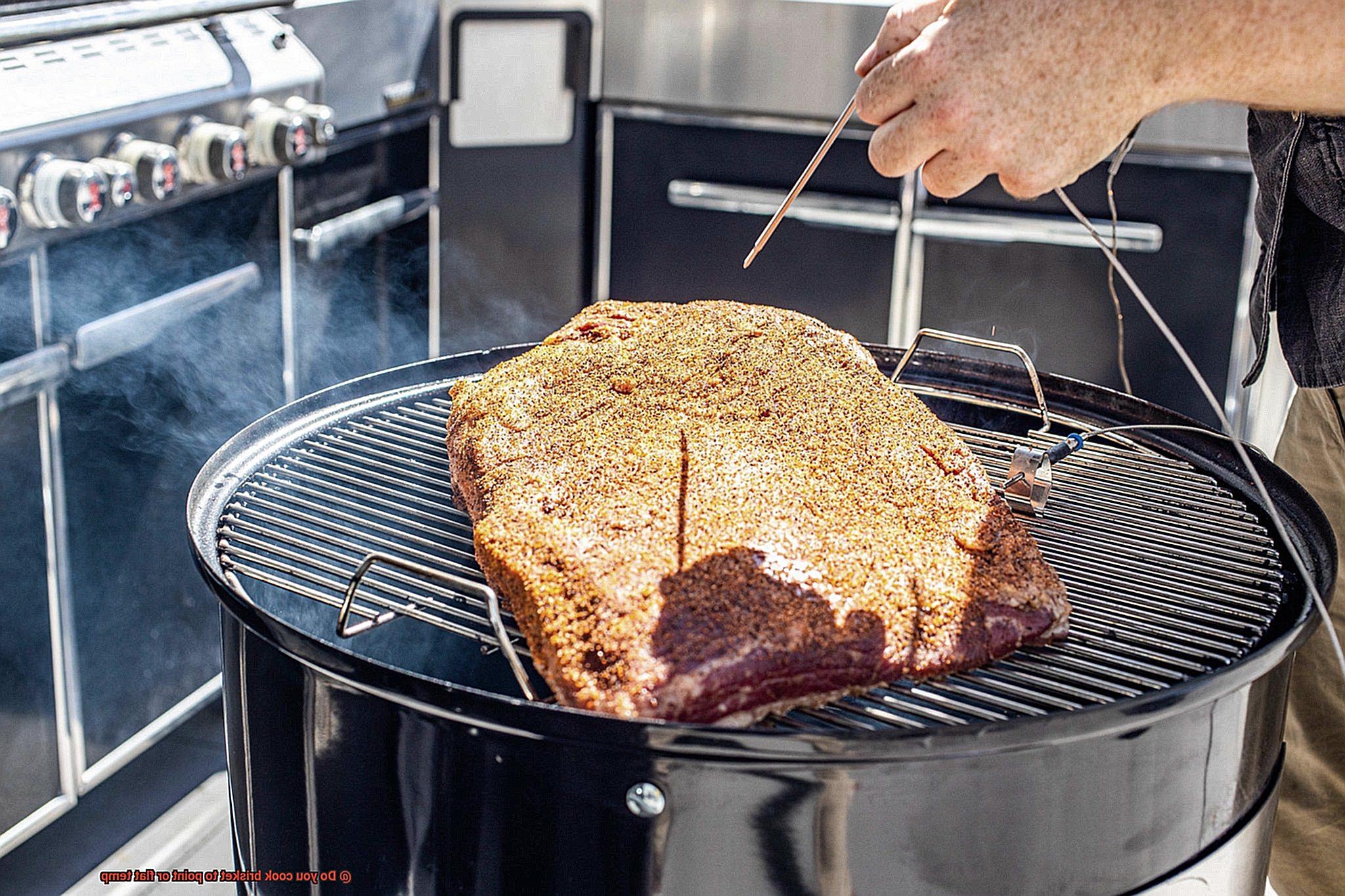
Ultimately, whether you cook your brisket to point or flat temp depends on your personal preference and experience. Some pitmasters prefer higher internal temperatures (around 203°F) to ensure both the point and flat are tender, while others prefer lower temperatures (around 195°F) to prevent the flat from drying out.
Cooking Brisket to the Point Temperature
The perfect tender and juicy texture can be confusing to achieve. Fear not, as we’re here to help. Today, we will discuss how to cook brisket to the point temperature.
Firstly, it’s crucial to understand that the point and flat muscles of a brisket require different cooking methods. The point muscle is fattier and more marbled, while the flat muscle is leaner. Therefore, if you’re looking for a more tender and flavorful end result, cooking your brisket to the point temperature is the way to go.
To start, preheat your smoker or grill to 225°F. Once heated up, place your brisket on the grates with the point muscle facing towards the heat source. From here, patience and precision are key. Cook your brisket for several hours until the internal temperature of the point muscle reaches 203°F.
Cooking brisket to the point temperature involves slow-cooking the point muscle until it reaches a temperature of around 203°F. This method is ideal for those who want a more tender and flavorful end product. The point muscle’s higher fat content will render down during cooking, resulting in a more succulent texture and richer flavor.
Once your brisket has reached that magical 203°F mark, remove it from the heat and let it rest for at least 30 minutes before slicing and serving. This resting period allows the juices to redistribute throughout the meat, enhancing its succulence and flavor.
In summary, cooking brisket to the point temperature takes practice but is well worth it. The end result is a mouth-watering masterpiece that’s sure to impress even the toughest BBQ critics.
To reiterate, here’s a quick recap of how to cook brisket to the point temperature:
- Preheat your smoker or grill to 225°F
- Place your brisket on the grates with the point muscle facing towards the heat source
- Cook for several hours until the internal temperature of the point muscle reaches 203°F
- Let it rest for at least 30 minutes before slicing and serving
Cooking Brisket to the Flat Temperature
Then, it’s time to learn how to cook your brisket to the flat temperature. This leaner part of the brisket may seem intimidating, but with a little patience and some tender loving care, you’ll be able to create a succulent and flavorful dish that will impress even the pickiest eaters.
First things first, let’s define what the flat is. This is the leaner part of the brisket, which means it requires a bit more attention and care during cooking. To achieve the desired internal temperature of around 195-205°F, you’ll need to use one of two popular methods: smoking or slow cooking.
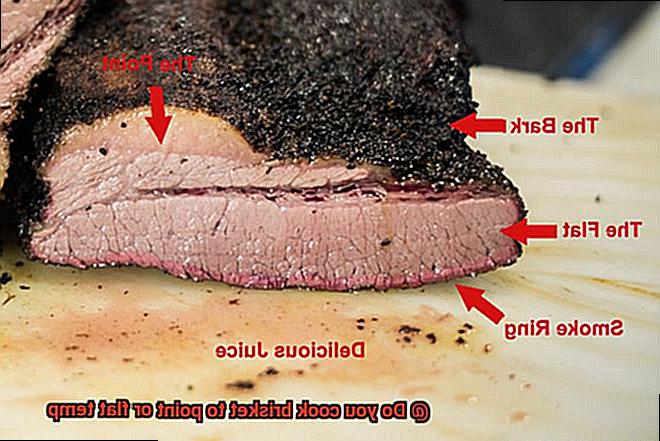
Smoking your brisket is a popular method, but it requires patience and attention to detail. You’ll want to smoke your brisket low and slow for several hours until it reaches that perfect temperature. Whether you’re using a smoker or a grill with a smoking attachment, keeping an eye on your meat thermometer is key. Overcooking or undercooking your brisket can result in tough or dry meat.
If you prefer slow cooking, then wrapping your brisket in foil or butcher paper and cooking at a low temperature for several hours will help lock in those delicious flavors while keeping your meat juicy and tender. This method also requires monitoring the internal temperature regularly with a meat thermometer.
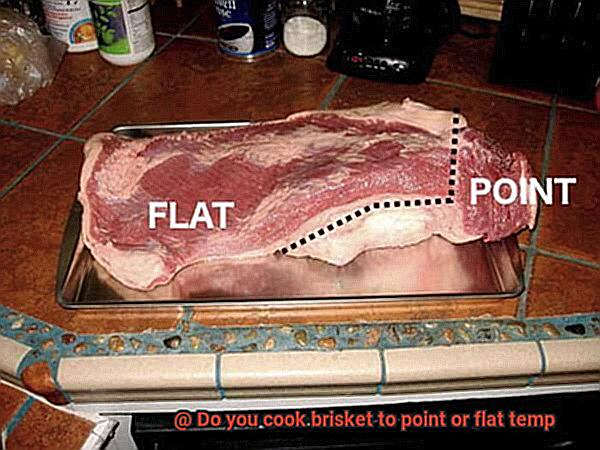
No matter which method you choose, remember that allowing your brisket to rest for at least 30 minutes before slicing is crucial. This allows all those yummy juices to redistribute throughout the meat, resulting in tender and juicy slices.
In conclusion, cooking brisket to the flat temperature requires patience and attention to detail. But with these tips and tricks, you’ll be able to create a mouth-watering dish that will leave your guests begging for seconds. So fire up that smoker or slow cooker and get ready to impress. Remember these key points in achieving the perfect flat temperature:
Pros and Cons of Cooking to Point vs. Flat Temperature
Each method has its own unique advantages and disadvantages, and it’s essential to understand them before deciding which one to use.
Cooking to the point temperature is a popular method that involves cooking the brisket until it reaches an internal temperature of 203 degrees Fahrenheit. This method results in a tender, juicy brisket with a soft and succulent texture that easily falls apart when sliced. This makes it perfect for sandwiches or serving diced, and some of its benefits include consistent results, tender meat, and easy slicing.
The consistency of cooking to the point temperature ensures that the brisket is cooked thoroughly and evenly, resulting in a consistent texture throughout. Additionally, this method breaks down tough collagen in the meat, leading to a tender and juicy texture that’s easy to slice. However, longer cooking times and the risk of overcooking can be downsides of this method. Furthermore, cooking to the point temperature can result in less bark since the meat is cooked for longer at a lower temperature.
On the other hand, cooking to the flat temperature involves cooking the brisket until it reaches an internal temperature of 180-190 degrees Fahrenheit. This method is popular because it leads to a crispy bark on the outside with a firmer texture on the inside.
Cooking to the flat temperature takes only 6-8 hours compared to cooking to the point temperature’s 10-16 hours. Additionally, this method results in a crispy bark on the outside of the meat and a firmer texture that holds up well when sliced. However, inconsistent results and tougher meat can be downsides of this method.
Tips for Achieving Perfectly Cooked Brisket Every Time
Perfectly cooked brisket is a delicacy that’s sure to impress anyone at the dinner table. However, achieving that perfect texture and flavor can be tricky. Here are some tips to ensure your brisket turns out perfectly every time.
Choose the Right Cut of Meat
Selecting the right cut of meat is essential to achieving perfectly cooked brisket. Look for a well-marbled piece that’s between 10-14 pounds with consistent thickness from end to end. The marbling is important because it adds flavor and keeps the meat moist during cooking.
Prepare Your Smoker or Grill Correctly
Preparing your smoker or grill correctly is crucial for achieving perfect brisket. Set it up for indirect heat and maintain a steady temperature of around 225-250°F. This will allow the fat to render down, making the meat tender and juicy.
Cook to Point or Flat Temperature
The decision to cook to point or flat temperature ultimately comes down to personal preference. Cooking to the point temperature involves cooking until the thickest part of the brisket reaches an internal temperature of around 203°F, while cooking to the flat temperature involves cooking until the thinnest part of the brisket reaches an internal temperature of around 195°F.
Use a Rub or Marinade
A rub or marinade can enhance the flavor of your brisket, making it even more delicious. A simple blend of salt, pepper, garlic powder, and paprika works great, but feel free to experiment with different flavors to find your perfect blend.
Don’t Rush the Process
Brisket takes time and patience to cook correctly, so don’t rush the process. Plan for about 1-1.5 hours of cook time per pound of meat and be prepared for a long day by stocking up on snacks and drinks and keeping your smoker or grill well-maintained. Wrapping your brisket in butcher paper or aluminum foil during the cooking process can also help retain moisture and prevent the meat from drying out.
Common Mistakes to Avoid When Cooking Brisket
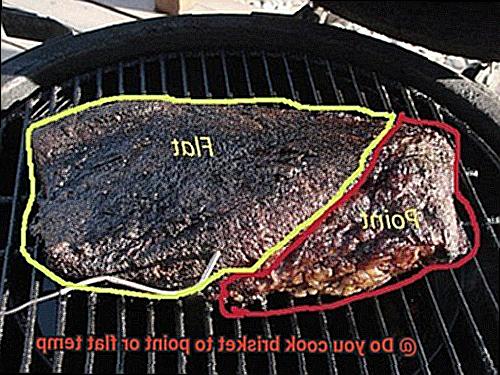
By avoiding these common mistakes, you can ensure that your brisket turns out perfectly every time.
Let’s start with trimming the fat. While brisket is naturally fatty, too much fat can lead to a greasy and unappetizing end result. To avoid this mistake, make sure to trim the fat cap down to about ¼ inch before cooking.
Seasoning is another crucial element to perfecting your brisket. As a large cut of meat, it needs plenty of seasoning to ensure that the flavor permeates throughout. Don’t be afraid to use generous amounts of salt, pepper, and any other seasonings you prefer.
When it comes to cooking temperature, remember the mantra: low and slow. Brisket needs to be cooked at a temperature below 275°F in order to break down the tough connective tissues and become tender. Cooking at too high a temperature will cause the meat to dry out and leave you with a less-than-perfect end result.
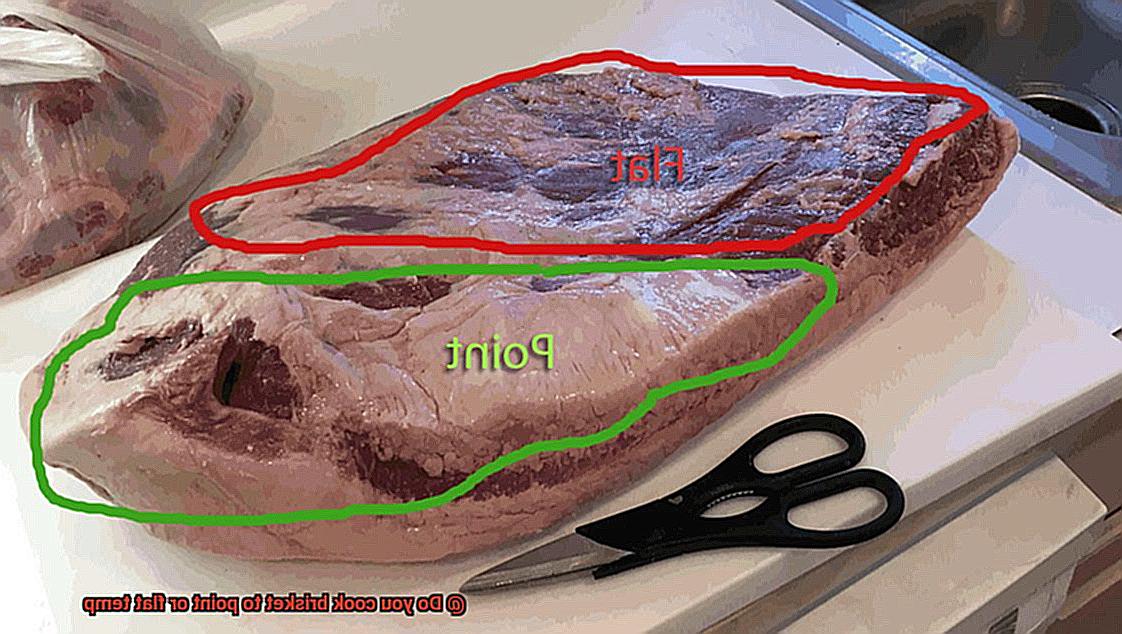
And finally, don’t forget the importance of letting your brisket rest after cooking. This step is crucial for ensuring that the juices redistribute throughout the meat, making it more tender and flavorful. Give your brisket at least 30 minutes to rest before slicing into it – trust me, it’ll be worth the wait.
Different Methods of Smoking a Brisket
Smoking a brisket is an art form that requires time, patience, and a little bit of experimentation. But fear not, because there are several different methods to choose from, each with its own unique advantages. So, let’s dive in and explore the various techniques for smoking a brisket.
First up is the Hot and Fast method. This technique involves cooking the brisket at a higher temperature for a shorter period of time. The result is a more tender brisket with a slightly different flavor profile. This method is perfect for those who want to enjoy a delicious meal but are short on time. The high heat creates a beautiful crust on the outside while keeping the inside juicy.
Next is the classic Low and Slow method, which involves cooking the brisket at a lower temperature for a longer period of time. This technique allows the connective tissues to break down slowly, resulting in a more tender and flavorful brisket. This method is perfect for those who enjoy savoring the process and appreciate the deep flavors of meat that come with low and slow cooking.
For those who want to speed up the cook time without sacrificing tenderness, try the Texas Crutch method. This technique involves wrapping the brisket in foil or butcher paper halfway through the cooking process to help retain moisture. While it can produce a more tender brisket, some argue that it can also result in a less smoky flavor.
Last but not least is the Reverse Sear method, which involves smoking the brisket until it reaches an internal temperature of around 160°F, then finishing it off by searing it over high heat to create a crispy crust. This technique results in a more unique texture and flavor profile that will undoubtedly impress your taste buds.
How Long Does it Take to Cook a Brisket?
The first thing you need to know is that it’s not a quick process. A brisket can take anywhere from 8 to 16 hours to cook, with an average cooking time of around 12 hours. But trust us, the end result is worth every minute.
The key to cooking a delicious brisket is using a low and slow cooking method. This means cooking the brisket at a low temperature for a long period of time. The reason behind this is that brisket is a tough cut of meat that requires time to break down the connective tissue and become tender. Rushing the cooking process will result in a tough and chewy brisket that nobody wants to eat.
So, what temperature should you be cooking your brisket at? The ideal temperature range is between 225-250°F. However, some people even choose to cook their brisket at an even lower temperature of around 200°F for an even longer period of time, resulting in a melt-in-your-mouth experience.
But don’t forget to monitor the internal temperature of your brisket throughout the cooking process. The ideal temperature for a fully cooked brisket is around 190-205°F. By using a meat thermometer, you can check the internal temperature and ensure that your brisket is cooked to perfection.
Now, let’s talk about size. The cooking time can vary depending on the size of the brisket. A general rule of thumb is to allocate about one hour and fifteen minutes per pound of meat. This means that if you have a 10-pound brisket, it will take approximately 12-15 hours to cook.
In addition to size, the cooking method used can also affect the cooking time. If you’re using a smoker or grill, it may take longer than if you’re using an oven. However, the result will be a smoky and flavorful brisket that is sure to impress.
8OiaypcnXDk” >
Conclusion
In summary, the decision to cook brisket to point or flat temperature is a matter of personal preference and experience. Cooking to the point temperature, which is around 203°F, results in a tender and juicy cut that melts in your mouth. On the other hand, cooking to flat temperature (around 195°F) produces a leaner cut with a firmer texture.
To achieve perfectly cooked brisket every time, it’s crucial to select the right cut of meat, prepare your smoker or grill correctly, and use rubs or marinades. Additionally, it’s essential not to rush the process and avoid common mistakes such as trimming too much fat or under-seasoning.
Various methods of smoking brisket include hot and fast, low and slow, Texas crutch, and reverse sear. Each technique has its unique advantages that can produce mouth-watering results.
It’s important to note that cooking time can vary depending on the size of the brisket and the method used. Generally speaking, you should plan for approximately one hour and fifteen minutes per pound of meat. And don’t forget to monitor the internal temperature with a meat thermometer for accuracy.
With these tips in mind, you’ll be able to create a masterpiece that will leave your taste buds begging for more.

